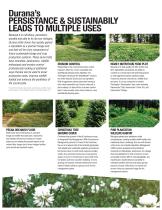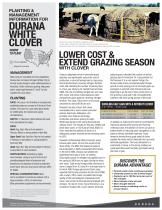
Catalog excerpts

WHERE TO PLANT ■ Primary adaptation □ Adapted to some sites DURABLE and SUSTAINABLE ALL PURPOSE WHITE CLOVER White clover is used extensively throughout the world as a cool season pasture legume. Research has repeatedly shown that adding white clover to grass pastures results in improved animal performance while reducing the need for nitrogen fertilizer application. A limiting factor for clover use has been its poor persistence under grazing systems in many areas of the U.S. Scientists have linked low stolen density to the poor persistence of white clovers. Much of the breeding work on white clover has focused on ladino types which are high yielding, but possess a low number of stolons compared to stolon-dense common and wild types. Seeing the potential of perennial white clover as a low input, effective and sustainable livestock forage, Dr. Joe Bouton, a former University of Georgia plant breeder and previous Director of the Noble Foundation Forage Improvement Division, initiated an aggressive white clover breeding program. His goal was to find a white clover with similar nutritional and agronomical attributes of traditional ladino clovers, but one that would be superior to ladino in persistence and grazing ENTRY % BASAL COVER DURANA I \43 REGAL I Hi Percent basal cover of white clover varieties continuously grazed. Planted November 1, 2006 at the UGA Central Georgia Branch Experiment Station, Eatonton, Ga. tolerance. Dr. Bouton began by collecting white clover ecotypes growing naturally and competitively in Georgia pastures. These ecotypes were exclusively the stolon-dense types and formed the parental base for the breeding program that developed “Durana.” In Bouton’s research, Durana interseeded into tall fescue pastures maintained a clover percentage over a two year period of 43 percent by weight while the amount of Regal ladino clover fell to less than 5%. Beef steer gains over this two-year period averaged 2.5 lbs/hd/day for Durana and fescue mixed pasture; 2.0 lbs/hd/day for the Regal mixed pasture and 1.4 lbs/hd/day on pasture fertilized with 65 lbs N/A and no clover. Based on these results and others, Dr. Bouton and AgResearch-NZ released Durana for commercial use in 2003. It is marketed exclusively by Pennington Seed, Inc. (Information contained in this article was taken from an article entitled “Ecotype-derived White Clover Cultivars and Their Place in the Southern Great Plains” by Dr. Joe Bouton, former Director, Noble Foundation’s Forage Improvement Division)
Open the catalog to page 1
For specific information about each use of Durana, visit the Durana Place making it a natural fit as an erosion control product page on the Pennington website atwww.pennington.com plant. It also provides color which makes for more aesthetically pleasing areas. Because it is nutritious, persistent, durable and able to fix its own nitrogen, Durana white clover has quickly gained a reputation as a premier forage and one that will be a key component of future sustainable forage and crop production systems. These same traits have scientists, landowners, wildlife enthusiasts and erosion...
Open the catalog to page 2
WHOLE TRUTH about DURANA WHITE CLOVER «, k,. k.,.,.,,,.,,,, There has long been a need for a persistent, productive, long-lived clover for wildlife food plots that is highly competitive in a mixed stand with perennial grasses or other aggressive plants including weeds. Along comes Durana white clover, the product of Dr. Joe Bouton, renowned plant breeder formerly at the University of Georgia and currently with the Noble Foundation in Oklahoma. “Durana will last at least three times longer than common ladino white clovers on the market today,” said Dr. Carl Hoveland, senior researcher with...
Open the catalog to page 3
PLANTING & MANAGEMENT INFORMATION FOR DURANA WHITE CLOVER WHERE TO PLANT Primary adaptation Adapted to some sites MANAGEMENT Seed come pre-inoculated and once established, Durana does not require nitrogen fertilizer. Clip or harvest surplus forage in under-utilized pastures or food plots. Under continuous grazing, keep grass and/or weed height between 2” and 6” to help maintain the clover stand. PLANTING RATE: 3 lbs./acre if no-till drilled or broadcast into established pastures; increase to 4 lbs./acre if frost seeded; 5 lbs./acre for a pure stand (pure stands for wildlife plots; for...
Open the catalog to page 4All Pennington catalogs and technical brochures
-
JESUP MAXQ II
2 Pages
-
MaxQ
2 Pages
-
Wintergrazer 70 Rye
1 Pages
-
AU SUNRISE
2 Pages
-
Patriot White Clover
1 Pages
-
Cheyenne II
1 Pages
-
COVER CROPS
6 Pages
-
Sahara II
1 Pages
-
AU Sunrise Brochure
2 Pages
-
PEW24 Bermuda
2 Pages
-
Durana Pecan Orchards
5 Pages
-
durana wildlife food plots
6 Pages
-
Arden
1 Pages
-
SUPERGRAZE
2 Pages
-
Mallard
2 Pages
-
Athletic Field Mixture
1 Pages

















